 Go to the
Archive index
Go to the
Archive indexIt's been such a long time that that old rusty bicycle has dwelt in the corner of our garage. So, one day, with curiosity I asked my dad, "Well, what is that old bicycle lying in our garage?" "Oh, it's an old Solex frame that belonged to your uncle a long time ago; it had a Mosquito engine clipped on beneath it." The answer took me by surprise. "So, dad, do you still have this Mosquito engine intact?" My dad replied, "Yes, I kept it complete with all its spare parts, but it's useless. The engine was dead because there is no spark. Maybe there is a fault in its magneto generator system."
So, then we began the restoration project of our Mosquito. Firstly, we tried to repair and make ready the bicycle. The old tyre had a diameter size of 25, not a common bike tyre size here, so I replace it to become 26×1-3/8 for ease of later replacement. Luckily for us, all the bicycle frame, brake, pedals, gears, etc, are still intact so there is no difficulty in repairing the bike. Not so long after some cleaning, the bicycle is up and ready. Then we move on to repair the Mosquito engine. After some quick study by browsing the Internet, I learn that our Mosquito is a model 38A. Fortunately, all the parts are still intact, that includes the carburettor, gasoline tank, the engine block, the gas and decompressor cable, the mounting bracket, the roller drive and exhaust manifold. But, as is commonly found in old engines, the main problem is in the ignition system. This is beyond the understanding of me and my father. So we take the engine to my father's old friend, who is a motorcycle mechanic, the owner of a motorcycle service centre. For the antique engine, we need someone who we can trust to understand better the engine's problem. After all, we want to repair it not to damage it more! Quickly the old man discovers that the main problem is a fault in the magneto. Maybe the coil inside the magneto's generator has burnt out or short circuited. So, the possible repair is to rewind the generator. But once he dismantles the generator, problems arise. He finds that the copper wire for generator is very thin, something that is simply not available at this time in my country. That's how the Mosquito can effectively generate a good spark just from its generator and points ignition system. So, we decide to rewind the generator using a copper wire size commonly available here.
After we replace and install the generator and magneto back to its place, we move forward to install the engine in the bicycle frame. It's not too difficult, thanks to the Mosquito's simplicity and unique design, which is made to clip on beneath any available bicycle. It's not too long before the bicycle now becomes an autocycle.
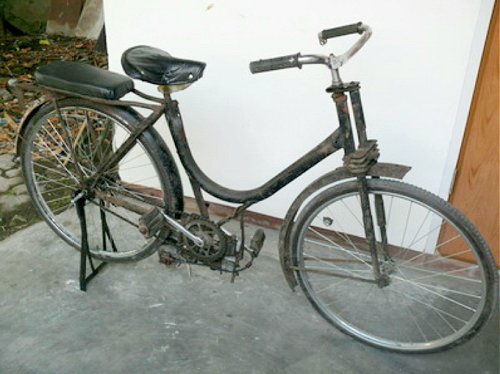
First Installation on Solex Frame
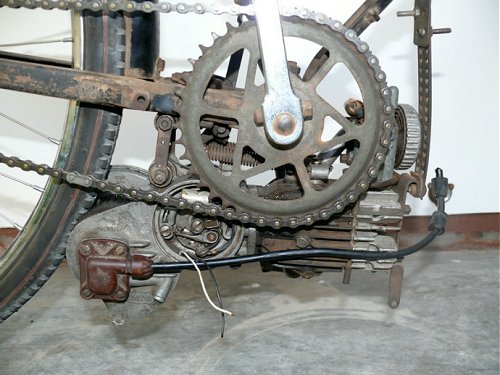
Rewound Generator Bypassing Original Points
We still concentrate on the ignition problem. So we just connect the engine to the bicycle tyre and try pedalling as fast as we can, without gasoline tank, carburettor or spark plug installed. Using a Voltmeter, we found the voltage produced is only around 50V AC. Well, it's not enough to ignite the spark plug. We must think of something else. Then comes an idea: what about applying new technology to this old engine? CDI! It's the solution for this engine to go back to its running function, although we must sacrifice the original ignition system. So, again, I spend more hours browsing the Internet looking for a way how and which CDI must I use. Thanks to a local Internet motorcycle community forum here, they suggest to me to use a simple CDI and ignition coil. So, after some research, I find that a Suzuki RC100 CDI unit is most suitable for my purpose. The CDI unit only needs input AC voltage from the magneto generator resulting in a bigger voltage to feed the ignition coil. Then, using the ignition coil and high-tension cable, a spark will be generated. The CDI Unit & ignition coil didn't cost too much for me to buy. And it's easy to install - only needing some cables installed. Then, voilà, after more hard pedalling, for the first time after 40 years of hibernation (I believe that my uncle didn't use the motor since around 1968), the Mosquito engine produces a spark! It's ready to live again!
A small light from the spark means bigger incentive for us to finish the project faster. Now we move forward to install the carburettor and the gas & decompressor cables, also the exhaust manifold. It's amazing me how my father kept these small pieces in good condition, especially the carburettor all in complete condition. So, installation won't give us too many problems. We clean the old rusty fuel tank. Although the inside of the tank is very dirty and rusty, the tank is still in good condition, no small needle holes found. We only change the tank's stop valve (the old one is broken) and add a fuel filter to prevent dirt coming to the carburettor. Then, we install the gasoline tank back to its place and make a final inspection of all electric cables and gasoline hose because we don't want then to catch when we are pedalling it.
OK, everything's in its place. Now, it's time to fire up this old engine. We add some mixture of petrol and oil to the tank. Of course, I still didn't know how to actually turn on the engine, so it's my 75-old-year dad's honour to start pedalling the bicycle. While I hold the bicycle try to keep it stable, my poor dad cranks the pedal very hard. But nothing happens! After some time he gave up. So, what's wrong with this engine? We quickly remove the spark plug and find that its tip is very wet with oil from the fuel mixture. After cleaning, we test for a spark by grounding it to the engine head block. And it still can produce big spark. We conclude that the problem is from the fuel mixture that is entering the combustion chamber, maybe it's too rich with oil. We decide to remove the gasoline mixture and fill the tank with a new one, this time pure gasoline without oil. Now, back on the saddle, my dad pedals the engine. The engine is coughing again and again and then, suddenly, the engine is alive with a noisy two-stroke sound. The CDI & ignition coil idea is working. I and my dad keep smiling at each other. We're very happy that after a long time this old engine can run again. To see how the old roller drive turns the tyre, enablong the engine to take over from the man's power... it's amazing me how, at that time, Garelli created this engine so efficiently.
After some minor adjustment, we're ready to test the autocycle on the road. We add oil again to the gasoline tank, this time not too much - to avoid the wet spark plug problem but still gave enough lubrication for the engine to run. This is the first test drive, so again, my old dad has a chance to drive the Mosquito. Hope he still remembers how to do it! The engine starts easily after some cranking. The old autocycle is running happily on the road again. I never thought that it could run quite fast for, let's say, for a bicycle that has a small engine on it, about 20-25 km/h. A lot of pedestrians stop and other drivers slow their cars or motorcycles to see it. It's a glorious moment for us. Not to forget the sound of the decompressor being pushed to shut off the engine... JUZZZZZ... very classical to hear.
And when it's my first time to test it, well I'm kinda afraid I can not control the autocycle, especially how and when I must brake & cut off the engine. But soon my fear turns to addiction once I know it's very easy to drive and make manoeuvres using this engine.

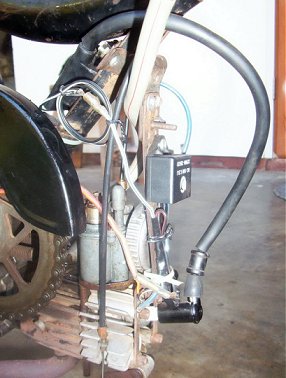
Complete Installation after Modification Using CDI & Ignition
Coil
Now, on a Sunday morning where the road is still not too busy with cars, we use the Mosquito to ride around our neighbourhood area. It's very nice drive. The engine starts easily and, when running, it purrs happily. Now using CDI & Ignition coil, I think there is some improvement on the ignition's spark. Also we won't need to worry about adjusting the points again. Just an old engine with new technology inside it - the Garelli Mosquito 38A is officially restored!
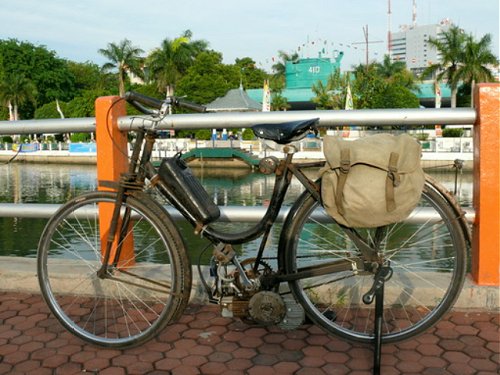
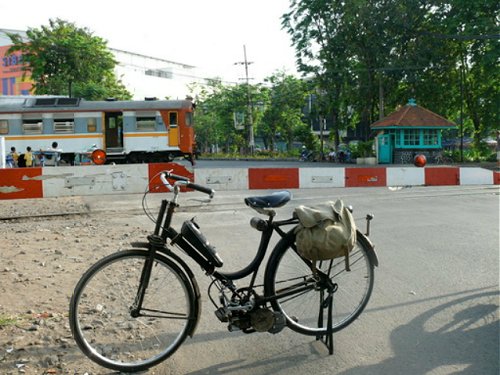
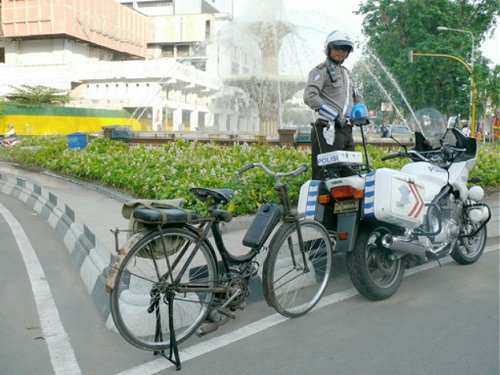
Back on the Road Again during the Real First Trial
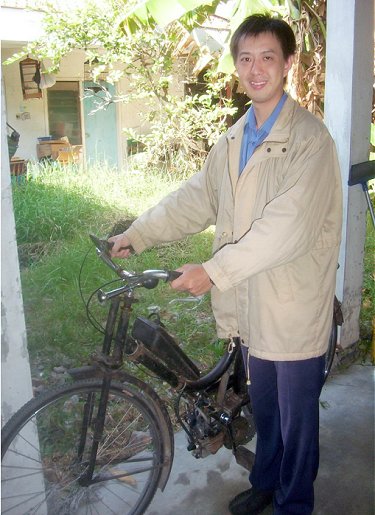
Vincent with the Mosquito
This article was written by Vincent Qiu from Surabaya,
Indonesia.
Photographs and original text © 2008,
Vincent Qiu
This version of English text © 2008, Vincent Qiu and Andrew
Pattle